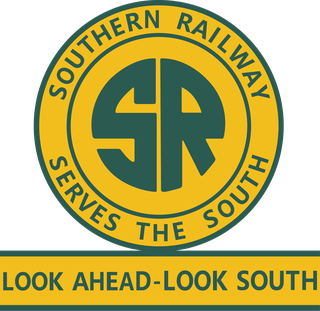
The Southern Railway is a name of a class 1 railroad that was based in the Southern United States. The railroad is the product of nearly 150 predecessor lines that were combined, reorganized and recombined beginning in the 1830s, formally becoming the Southern Railway in 1894.
The Tennessee Central Railway was founded in 1884 as the Nashville and Knoxville Railroad by Alexander S. Crawford. It was an attempt to open up a rail route from the coal and minerals of East Tennessee to the markets of the midstate, a service which many businessmen felt was not being adequately provided by the existing railroad companies. They also wanted to ship coal and iron ore to the Northeastern US over the Cincinnati Southern Railway, which was leased to the Southern and operated as the Cincinnati, New Orleans and Texas Pacific Railway [CNOTP], through their Cincinnati gateway. The N&K was only completed between Lebanon, where it connected to a Nashville, Chattanooga and St. Louis Railway branch from Nashville, and Standing Stone.

The Richmond and Danville Railroad (R&D) Company was a railroad that operated independently from 1847 until 1894, first in the U.S. state of Virginia and later on 3,300 miles (5,300 km) of track in nine states.
Algernon Sidney Buford of Chatham, Virginia, is best known for his presidency of the Richmond and Danville Railroad during its massive post civil war expansion into the Southern Railway system.

The Norfolk Southern Railway was the final name of a railroad that ran from Norfolk, Virginia, southwest and west to Charlotte, North Carolina. It was acquired by the Southern Railway in 1974, which merged with the Norfolk and Western Railway in 1982 to form the current Norfolk Southern Railway.
The Augusta and Knoxville Railroad (A&K) was a railroad company that operated on 66 miles (106 km) of track between Augusta, Georgia, and Greenwood, South Carolina, from 1882 to 1886. It was merged with three other companies to form the Port Royal and Western Carolina Railway, which was reorganized in 1896 as the Charleston and Western Carolina Railway.
The Charleston and Western Carolina Railway (C&WC) was formed in 1896 to operate the lines of the former Port Royal and Augusta Railway (PR&A) and the Port Royal and Western Carolina Railway (PR&WC). The PR&A and PR&WC had originally been part of the Central of Georgia Railroad but the South Carolina Legislature had forced the railroad to give up the subsidiary lines. The Atlantic Coast Line Railroad (ACL) took over the C&WC in 1897 but operated it as a subsidiary until 1959 when the ACL fully absorbed it. Much of the original system is still in use by ACL successor CSX Transportation.

The East Tennessee, Virginia and Georgia Railroad (ETV&G) was a rail transport system that operated in the southeastern United States during the late 19th century. Created with the consolidation of the East Tennessee and Virginia Railroad and the East Tennessee and Georgia Railroad in 1869, the ETV&G played an important role in connecting East Tennessee and other isolated parts of Southern Appalachia with the rest of the country, and helped make Knoxville one of the region's major wholesaling centers. In 1894, the ETV&G merged with the Richmond and Danville Railroad to form the Southern Railway.
The Piedmont & Northern Railway was a heavy electric interurban company operating over two disconnected divisions in North and South Carolina. Tracks spanned 128 miles (206 km) total between the two segments, with the northern division running 24 miles (39 km) from Charlotte, to Gastonia, North Carolina, including a three-mile (5 km) spur to Belmont. The southern division main line ran 89 miles (143 km) from Greenwood to Spartanburg, South Carolina, with a 12 mi (19 km) spur to Anderson. Initially the railroad was electrified at 1500 volts DC, however, much of the electrification was abandoned when dieselisation was completed in 1954.

John Stephen "Jack" Casement was a general and brigade commander in the Union Army during the American Civil War and a noted railroad contractor and civil engineer. He directed the construction of the Union Pacific's section of the Transcontinental Railroad, which linked the Western United States with the East.
The McCormick Subdivision is a railroad line owned and operated by CSX Transportation in the U.S. states of Georgia and South Carolina. The line runs from Augusta, Georgia to Greenwood, South Carolina, for a distance of 62.8 miles (101.1 km). At its south end the line continues north from the Augusta Subdivision and at its north end the line continues north as the Monroe Subdivision.
The Greenville and Columbia Railroad was a 5 ft gauge railroad that served South Carolina in the 19th century.
The Spartanburg, Union and Columbia Railroad was a successor railroad to the Spartanburg and Union Railroad.
The Port Royal and Augusta Railway was a South Carolina railroad that existed in the latter half of the 19th century.
The Port Royal and Western Carolina Railway (PR&WC) was a railroad company in the southern United States that operated on 229 miles (369 km) of 4 ft 9 in gauge track. It was formed in 1886 by the merger of the Augusta and Knoxville Railroad, Greenwood, Laurens and Spartanburg Railroad, Savannah Valley Railroad and the Greenville and Laurens Railroad, which then joined with Port Royal and Augusta Railway.
The Augusta, Knoxville and Greenwood Railroad (AK&G) was a South Carolina railroad company chartered shortly after the end of the Reconstruction period.
The Carolina, Knoxville and Western Railway was a South Carolina railroad that existed in the latter half of the 19th century.
The Greenwood, Laurens and Spartanburg Railroad was a South Carolina railroad company begun after Reconstruction.

Roanoke is a train station in Roanoke, Virginia, served by Amtrak's Northeast Regional line. Built in 2017, it follows several other Roanoke passenger stations that operated from the 1850s to 1979.







